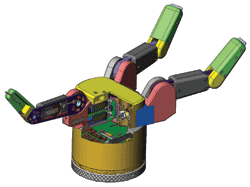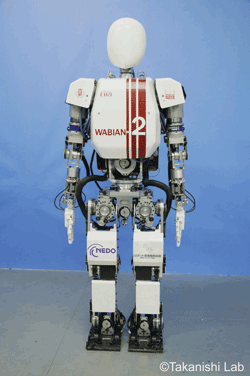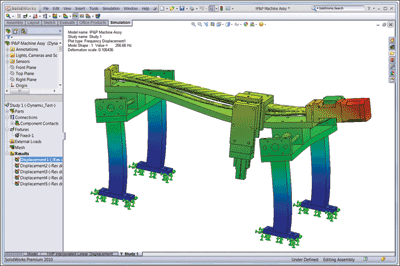What’s next in robotics design?
CAD tools evolve to advance robotics applications
BY MARIE PLANCHARD
Dassault Systèmes SolidWorks
Concord, MA
http://www.solidworks.com
Two decades ago, the introduction of 3D CAD technology ushered in the Golden Age of Robotics. Development of robotics technology, systems, and applications has mirrored similar advances in 3D design, visualization, and simulation tools. The two technologies have advanced in parallel because computer-based development allows inventors, designers, and engineers to move beyond a trial-and-error, build-and-test approach into the more efficient, affordable, and revealing world of virtual design.
Robotics and 3D CAD tools
In fact, the company recognized by The Guinness Book of World Records — Barrett Technology — as having developed the most advanced robot to date — the WAM robotic arm — was the very first licensee of the SolidWorks 3D CAD system in 1995. Since 3D CAD software became available in the 1990s, robotics technology has taken off in dramatic fashion. During the intervening years, the world has witnessed the entry of robots into many facets of modern society, from exploration and research to industrial applications and medical procedures.

The WAM robotic arm from Barrett Technology, Inc., is listed by The Guinness Book of World Records as the world’s most advanced robot.
The robotic rovers that made important discoveries on Mars and the remotely operated vehicles (ROVs) that explore the ocean’s depths were designed using 3D mechanical CAD software, as are today’s robotics-based manufacturing systems, such as automated packaging and pick-and-place machines. Surgeons are using robotics-based equipment that was designed with CAD software, like MAKO Surgical Corp.’s robotic arm orthopedic system, the system cleared for use in partial knee resurfacing by the U.S. Food and Drug Administration.
Robots and robotic systems have even become part of popular culture, through television shows like BattleBots and the numerous and growing competitive youth robotics teams that are now a major educational activity. At some high schools, colleges, and universities, the competitive robotics team garners as much enthusiasm and support as the school’s sports teams. The cornerstone of these educational efforts is often 3D CAD software, especially at the world’s leading research universities.
For example, at Waseda University’s Humanoid Robotics Institute in Japan, researchers use 3D CAD tools to study and create humanoid robots that look, move, and behave like people. This research focuses on creating robots that interact with people in the role of a companion or helper. Another research project at Virginia Tech University’s Robotics & Mechanisms Laboratory leverages robotics technology to develop a vehicle that the blind can drive.
3D CAD tools have facilitated the development of many of the robots and robotic systems that have emerged during this Golden Age of Robotics. The obvious question regarding the future of design tools — and their impact on new directions in robotics development — is, what comes next?
A multidisciplinary approach
The next evolutionary leap in robotics research and development involves a more multidisciplinary engineering approach and the availability of new CAD tools to support it. Robots and robotic systems comprise mechanical, electronic, and computing/control systems.
Each of these disciplines has its own set of engineering principles and design tools, and most robotics design projects require a mechanical, an electrical/electronic, and a control systems engineer. The traditional approach is to develop each subsystem separately, then integrate them and try to make them function together at the end of the process. This approach has successfully produced many of the aforementioned robotics designs.

The WABIAN-2R (WAseda BIpedal humANoid-No.2Refined) humanoid robot is designed to duplicate the motion of a human walking.
However, there are potential advantages — and possible breakthroughs — to taking a more multi-disciplinary approach. Designing robotics subsystems together from the beginning — instead of trying to integrate systems after the fact — can lead to the next generation of innovative applications in robotics.
The challenge in taking a more collaborative, multidisciplinary approach to robotics development is that each discipline has historically been a world unto itself, with its own objectives, tools, and vocabulary. Mechanical engineers, electronic systems designers, and controls programmers not only bring different perspectives to robotics system design, they also speak a different technical language. Fulfilling the promise of mechatronics — the synergistic convergence of mechanical engineering, electronic systems design, and controls programming — requires the establishment of a common framework within which robotics systems collaboration can take place.
Some colleges and universities are attempting to lay a mechatronics foundation by changing curriculums and degree programs. Schools that once only offered degrees in mechanical engineering, computer science, computer engineering, electronics, or electrical engineering (with concentrations in robotics) are now offering degrees in robotics engineering that incorporate all of the required disciplines.
Instead of teaching one student how to design a mechanical arm, another student how to create its electrical power drive, and a third student how to develop its control program, students in these new programs will learn how to do all three. More than likely, this skill and knowledge set will result in more advanced, innovative, and sophisticated robots.
To fully take advantage of mechatronics in robotics system development, designers need a single, virtual development environment that integrates mechanical, electronic, and systems control design tools so that everyone involved in the process can get the information they need and contribute the expertise they have to creating the robots of the future.
A new generation of tools
Advanced CAD tools are emerging that collectively establish an integrated, next-generation mechatronics design environment. On the surface, one might focus on visualization as the key to a multidisciplinary approach to robotics design, such as a movie or animation that shows how the robotic system will move and operate.
While visualization is indeed important, a true mechatronics design platform provides the ability to communicate important engineering information that electronics and controls engineers can use to select, size, and program the robotic system. Likewise, understanding how electronics and control systems will affect the mechanical design can help facilitate robotics development.

An integrated mechatronics design environment allows for mechanical simulation using information supplied by electronics and control systems design.
Robotics designers need more than animations to capitalize on mechatronics. They need access to mechanical-engineering information, such as mass, material properties, moments of inertia, and force/torque requirements, to choose the most suitable electronic control mechanism.
They need to combine the loads created by specific electronic controls with the output of dynamics analyses to ensure the robotic system’s structural integrity. They also need to be assured that the robot functions as intended without any mechanical or electronics systems issues.
The bottom line: an integrated mechatronics design environment supports the communication of mechanical, electronics, and controls information in all three directions, which can help robotics designers make important design decisions and modifications.
Some examples of true mechatronics design environments are the integration between SolidWorks Motion kinematics and dynamics analysis software and the two leading controls automation packages: LabVIEW from National Instruments and Motion Analyzer from Rockwell Automation. With these integrated mechatronics tools, the mechanical designer can model a robot in SolidWorks 3D CAD software and conduct kinematics and dynamics analyses in SolidWorks Motion software.
Then, electronic systems engineers and control programmers can access the entire motion simulation from either LabVIEW or Motion Analyzer, including pertinent engineering data such as force, torque, and friction requirements, to design and program the control system. Finally, the mechanical engineer can access detailed controls information, such as the type of device or the size of the motor utilized, to conduct additional stress and vibration analyses.
These next-generation mechatronics design tools provide a platform that robotics engineers need to optimize designs at the subsystem level. Just as 3D CAD software helped to launch the Golden Age of Robotics development, advanced mechatronics design environments will carry robotics development into an entirely new age — one limited only by the imagination and inventiveness of the engineers of tomorrow. ■
Advertisement
Learn more about SolidWorks





